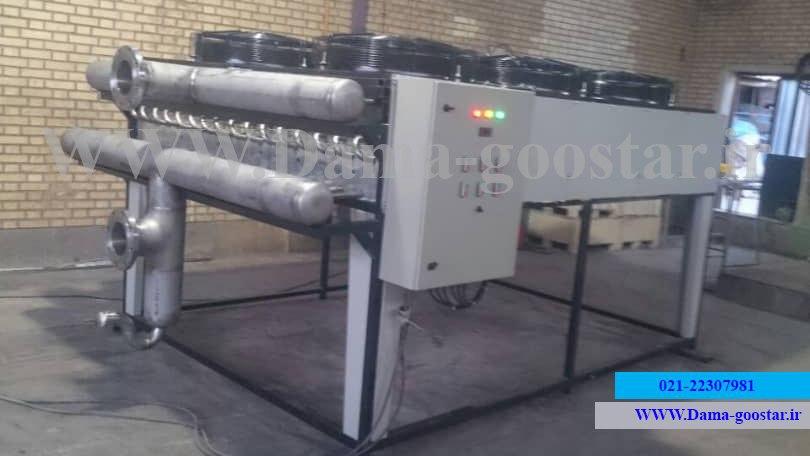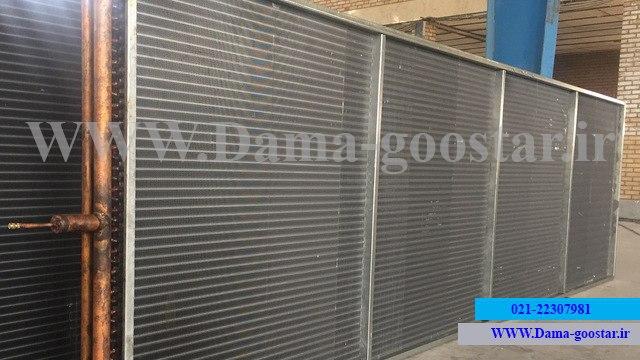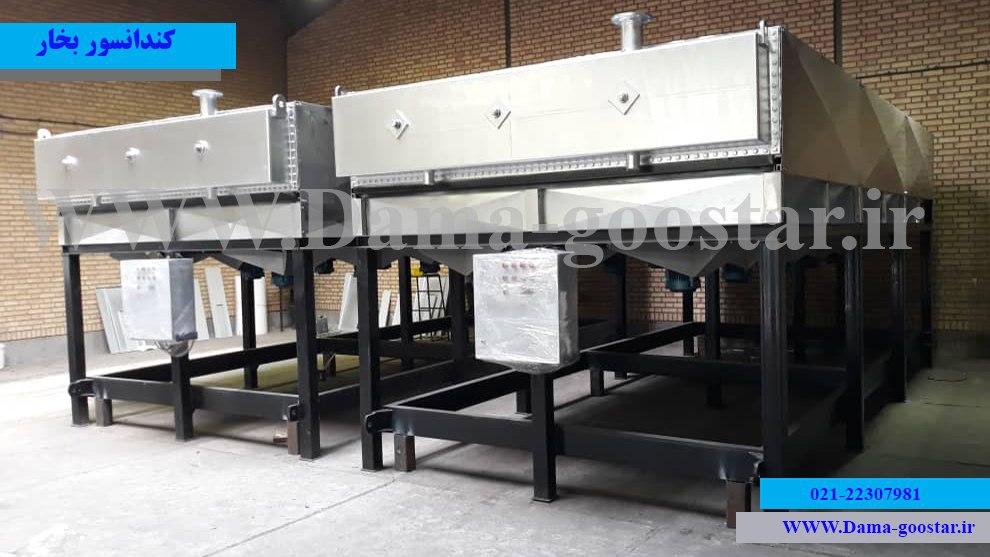Air Condenser or Cool Air Condenser is a type of dry cooling tower (Dry Cooling Tower) which is also referred to in English as Air Cooler and Dry Cooler. An air-cooled condenser is actually a type of water- cooled cooling tower that is commonly used in low-capacity refrigeration units due to its contact with dry air.
Due to the contact of water with the dry air flow of the outside environment, the air condenser reduces the water temperature to near the dry temperature of the environment, and this is the main reason for naming this equipment with the names of dry cooling tower and air conditioner. The fact that the air condenser reduces the temperature of the fluid to the dry temperature of the environment in some cases causes the use of this equipment to be limited in hot seasons. Also, in some climates where the weather in the region is hot and dry due to its proximity to the equator or mountainous conditions, the air condenser efficiency decreases. Observing the basic points in buying a condenser and choosing the best place to install the air conditioner are the most important factors in improving the performance of this device.
Why an air condenser?
In answer to this question, it should be stated that the reason for using air condensers or air conditioner valves is the impossibility of using water condensers in humid and sultry areas. Simply put, in areas where the relative humidity, ambient temperature (relative humidity) is above 80%, the dry environment temperature (Dry Bulb) and the ambient temperature (Wet Bulb) will generally be the same, and the use of water condensers that are not highly dependent on increasing humidity in the environment is practically possible.
In such areas, due to the better performance of air condensers or air conditioners, this equipment is used as the main source of water cooling. The dry or tangible temperature of humid areas is generally lower than that of dry areas due to the high relative humidity of the climate, which adds to the importance of using a dry cooling tower or air condenser.
Main components of air condenser:
1- Maintenance structure and main frame:
This section includes chassis columns made of studs or cans in different sizes on which the coil and other equipment are placed.
2- Panel sheets and side walls:
This part is riveted and connected after placing the fin coil to form a frame for the passage of air flow on the 4 sides of the air condenser.
3- Finned and non-finned coil for heat energy exchange:
This section consists of a large number of copper pipes enclosed in dense aluminum plates (fin), which is the most important part in heat exchange in the air condenser.
4- Suction fan or impeller:
An air condenser is an air-to-air heat exchanger that reduces the temperature of the fluid or refrigerant inside it and is responsible for creating air flow inside the condenser and on the coil surface of the impeller or fans installed on the device.
5- Remote reduction or power transmission system:
High-capacity cool air condensers generally have large fans, and such fans require less rotational speed, which is why belt, pulley, and gearbox reduction systems are available for this purpose. Coolers are used.
6- Engine or mechanical energy generator:
The energy required to rotate the fan and create negative pressure in the fan is provided by the electric motor, and in fact the most important part of the work entering the condenser is done through this and the power consumption of air condensers is taken from this part.
7- Protective control panel and air condenser control equipment:
In order to regulate the amount of energy consumption and control of electrical equipment (motor), protective and control equipment is used in the control panel.
8. Fan Guard nets:
Networks in the upper or lower part of the fan To prevent foreign objects from entering the fan section, this part is used as a fan guard or butterfly protector.
9-Flange and main collector of inlet and outlet of fluid or refrigerant:
This section is used to connect fluid or refrigerant piping to the condenser, which can be used as a gear head, flange or venturi depending on the type of performance or application.
10-Log lifting or loading hooks on both sides of the device:
This section consists of hooks to facilitate the loading process which is more used in high capacity air condensers.
11-Steam trap:
This part is mostly used in various types of steam condensers, the purpose of this part is to prevent steam from leaving the water outlet.
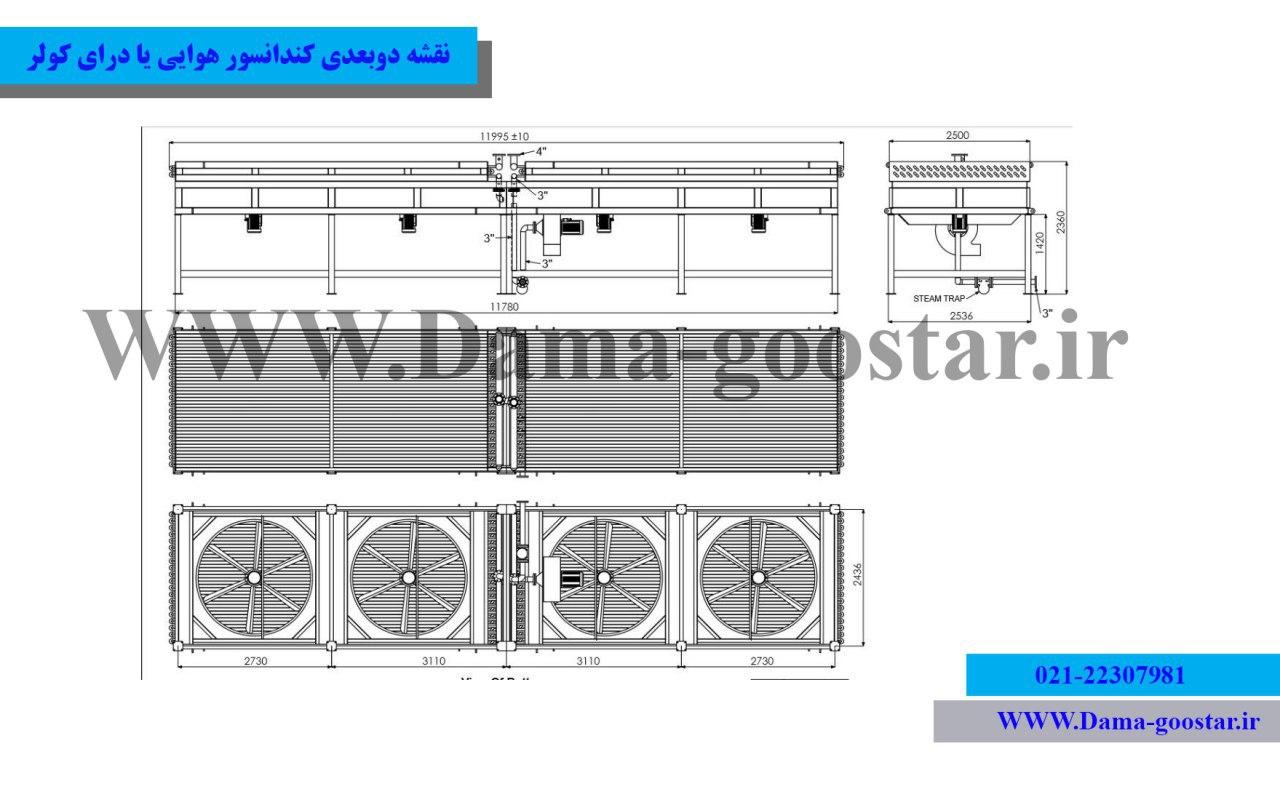
How is the capacity of an air condenser calculated?
The capacity of the condenser and cooling tower or dry cooling tower is a function of the amount of heat transfer surface of the condenser and the family of air cooler fans or fans. The more surface energy transfer pipes (coils) are used in the condenser, the more the air cooler or drive cooler will have the capacity to reduce the temperature, and the heat transfer from the water to the outside environment will be better and faster.
Therefore, high-capacity cooling units require a higher level of pipes (larger coil area) and a higher level of ventilation, which in most cases we have to use two or more coil circuits and a large number of impellers in the design of air conditioner or air conditioner. In order to calculate the capacity of the cooling air condenser, the formulas used in the cooling tower section can also be used. In the cooling tower calculation section , you can use the equations necessary to calculate the capacitor capacity.
Which model of fan is more suitable for air cooling systems?
The fan or impeller in air condensers is often of the axial flow type, which is relatively more efficient than the centrifugal or helical centrifugal model impellers. Axial or axial fans used in air condensers may produce a lot of noise if the design principles and standards are not followed. The permissible sound level for axial suction or blower fans or impellers in air condensers is set between 70 and 75 decibels in the design. In order to reduce the noise produced by the air condenser, inverter drive systems are generally used to reduce the fan speed to the nominal and standard speed.
However, apart from the discussion of noise generation, which can be solved by a series of design principles used in the axial impeller, the air conditioner has many advantages over other condensers using the axial aeration system (with axial fan) compared to other condensers. We pay:
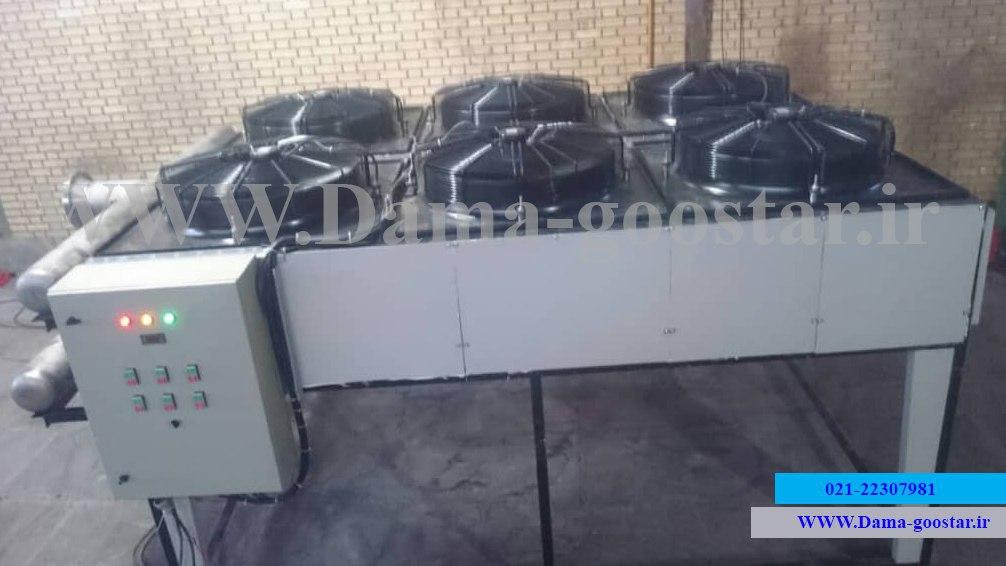
Application of control systems in air condenser or air conditioner
The use of variable speed control systems, or VFD control, in addition to reducing the noise generated by the condenser, drastically reduces power consumption in cold and temperate seasons. In fact, in cold seasons, the use of inverter system reduces the flow of air through the cross section of the condenser pipes, which will be compensated by reducing the ambient air temperature, and the effect of this function on the fluid outlet temperature of the cold air condenser is negligible. is.
In special situations where the issue of noise is very important, screw fans can be used to cool the water inside the air condenser. For example, in many units of integrated condenser chillers (single-piece) that are installed near the housing, the condensers have centrifugal screw fans.
Advantages of using an air condenser or dry cooler over an open (wet) cooling tower
- No need to consume water and provide water compensation such as a wet cooling tower
- Freezing of water within the circulating cycle of air-cooled condensers will be much less than evaporative and wet condensers.
- Sedimentation is much less frequent inside the water cycle.
- No need to harden the circulating water due to the closure of the water flow circuit inside the condenser and the coolant
- No need to provide peripheral equipment, including high pressure pumps, water reservoirs and earth dams
- Ability to install outdoors and split the cooling unit to prevent vibration and noise from entering the space
- Lower installation cost than evaporative condensers and wet or open condensers (cooler tower)
- Reduce energy costs in humid and humid areas
Disadvantages of air condenser or air conditioner
- Decreased efficiency due to sunlight
- Increase fluid temperature and decrease efficiency in hot seasons
- Lack of ideal use in hot and dry areas and close to the equator
- Requires control equipment and high cost
Air condenser price or cooler price
The price of air-cooled condenser will depend on the type of use for refrigerant or water-vapor cooling, the cooling capacity of the condenser (based on the refrigeration tone) or depending on the type of material used in the production of this equipment. Cool air condensers are more expensive than other types of air conditioner valves or air condensers due to their high importance in the category of peripheral equipment. Generally, steam air condensers are produced from all-steel coil equipment, which will increase the cost of this device due to the high price of steel pipes and fittings. Briefly, the main factors affecting the price of air condenser are as follows.
- The type of fluid cooled in the condenser
- Material used in the coil
- Coil type (with or without fan)
- Refrigeration capacity or cooling of air condenser
- Number of fans used in the condenser
- Type of control system and optional ancillary equipment used to control energy consumption
- Other factors such as flow fluid flow conditions, installation conditions, type of chassis material, etc.
